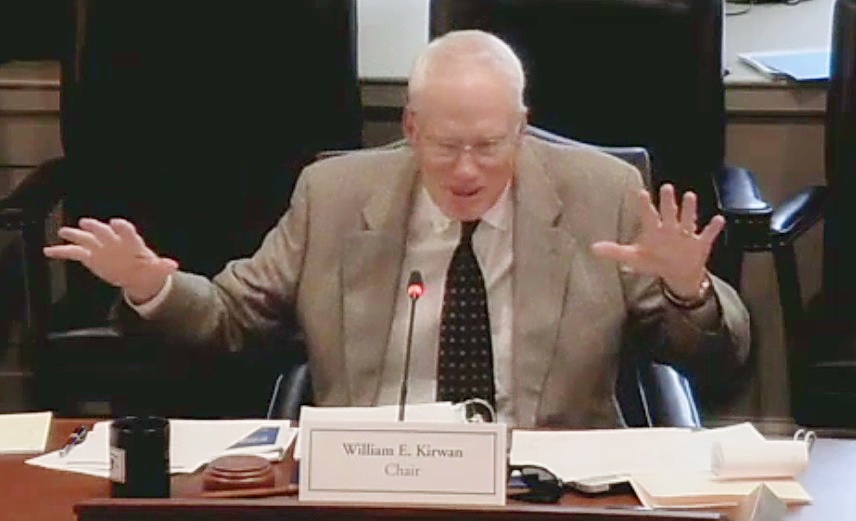By Megan Poinski
Megan@MarylandReporter.com
Maryland’s poultry industry is worth more than $600 million annually – but produces enough waste to pile up to the top of nearly two football stadiums and create about 40% of the phosphorus that pollutes the Chesapeake Bay, according to a report released Wednesday by Environment Maryland.
Much of the waste – manure from the birds and their bedding and feathers, a mixture called “chicken litter” – is often used by farmers as fertilizer for their fields. However, according to the study, chicken litter contains more phosphorus than crops usually need, and the excess often runs into the Chesapeake Bay. Phosphorus pollution leads to algae blooms forming in the water, creating large “dead zones” where animals cannot survive.
 “We really create so much waste each year, we have to come up with more ways to use it,” said Megan Cronin, the Chesapeake Bay program associate for Environment Maryland.
“We really create so much waste each year, we have to come up with more ways to use it,” said Megan Cronin, the Chesapeake Bay program associate for Environment Maryland.
Cronin said that the pollution caused by the poultry industry – nearly 300 million broiler chickens in 2007, producing about 550,000 tons of chicken litter – is starting to command more attention. The federal government is creating strict regulations to reduce pollution in the Chesapeake Bay.
Additionally the “P-index,” Maryland’s current method of measuring the amount of phosphorus that can be put on a field, still allows manure to be used as fertilizer on phosphorus-saturated fields. The U.S. Environmental Protection Agency has rejected the “P-index” because it finds that it can allow for excessive phosphorus runoff into the Bay.
Gov. Martin O’Malley’s administration has been working to update guidelines that regulate what farmers can place on their soil. In late October, the Maryland Agriculture Department submitted proposed changes to the state Nutrient Management Regulations Manual to the Joint Committee on Administrative, Executive and Legislative Review for approval. Cronin said the initial version of these changes was applauded by the environmental community.
If changes to the regulations are approved by the committee, they will be published in the Maryland Register for public comment and potential revision before they are implemented.
The Environment Maryland study recommends that new guidelines be developed to stop farmers from applying too much phosphorus-rich chicken litter to their soil. Cronin said this could include steps like prohibiting application while fields are frozen and less likely to absorb the nutrients, and requiring more of a wooded “buffer zone” be placed between fields and the waterways.
More poultry producers could also have their waste made into fertilizer pellets, which can more easily be moved away from the Chesapeake Bay and its already phosphorus-rich soil. For example, the Perdue AgriRecycle facility in Delaware pays to have poultry litter trucked in and made into pellets.
Last week, the Board of Public Works approved a 30-year lease for Maryland-based EcoCorp to build an anaerobic digester to turn chicken litter into electricity on land near Eastern Correctional Institute in Westover. James Harkins, director of Maryland Environmental Service, said that the plant will recycle up to 5,500 tons of poultry waste and supply about a quarter of the power for the prison. Harkins called the plan a “really grand pilot demonstration” to do something new with poultry waste.





This comment was received by e-mail from Bill Satterfield, Executive Director of Delmarva Poultry Industry, Inc.
Statement by Delmarva Poultry Industry, Inc. (DPI), the 2,000-member trade association for
the chicken industry on the Eastern Shore of Maryland, the Eastern Shore of Virginia, and Delaware.
The
publicity effort by Environment Maryland this week was another
misguided effort in an
on-going series of attacks upon the Delmarva Peninsula’s chicken
industry and farmers throughout the region who rely upon chicken manure,
a locally produced organic fertilizer created by the chickens that is a
valuable fertilizer that helps sustain conventional
farming in the region.
Using
state sanctioned and state reviewed nutrient management plans, farmers
use this organic
fertilizer to produce food for Maryland, the nation, and the world.
Farmers are required to develop and implement plans on where, how often,
and in what quantities fertilizers such as chicken manure/litter can be
applied to their lands. These plans are guided
by university and government recommendations and requirements that are
the strictest in the nation.
Chicken
manure is a valuable farm fertilizer that is in short supply in the
region. Many
farmers wishing to use it cannot find it. The best use of this locally
produced organic fertilizer is as a farm fertilizer. It most
definitely
is not a waste product as its critic decry. Many chicken growers
add to their family income through the sale of this fertilizer to other
farmers. For many crop farmers, a ton of chicken litter has a
fertilizer value of up to $100 per ton. In addition
to helping keep crop farmers in business, this organic fertilizer adds
micronutrients to the soil that help increase plant growth and
production. This results in more nutrient uptake by the plants and less
pollution. Often times these micronutrients are
not found in commercial fertilizers. The organic material in the
litter also helps with water retention and reduces the movement of
nutrients to waters of the state.
According
to the EPA-approved December 2010 Maryland Chesapeake Bay Watershed
Implementation
Plan, Maryland chicken manure is responsible for just six percent of
the nitrogen entering the bay from all Maryland sources. It is not the
huge problem some people and groups seem to believe it is.
While
some farmers cannot use the chicken manure because of high phosphorus
levels in their
soils, several programs already are in place to move their locally
produced organic fertilizer to land where it can be used. These include
the state’s manure transport program funded in large part by the
state’s chicken companies and the Perdue AgriRecycle
plant in southern Delaware that converts the manure into a pelleted
organic fertilizer that largely is moved out of the Chesapeake Bay
Watershed states. Possible new uses of the manure, announced in recent
weeks, are a manure-to-energy plant at the Eastern
Correctional Institute in Somerset County and a manure-to-electricity
plant on property owned by Perdue Farms near Salisbury.
Environment
Maryland’s aim seems to be to destroy family farms and to drive farmers
and much
coveted open spaces out of Maryland. Further restrictions and
unnecessary prohibitions on the use of this organic fertilizer on crop
fields will only result in the destruction of family farms while
increasing the amount of impervious surfaces, increased development
in rural areas, additional congestion, and more urban/suburban
pollution in Maryland.
If
Environment Maryland truly was interested in improving the quality of
water in Maryland
and in the Chesapeake Bay, it would focus its efforts on the spillages
of raw sewage into waters of the state. In 2011 alone, just in the
state of Maryland, wastewater treatment plants have reported to the
Maryland Department of the Environment that more
than 1.5 billion gallons of wastewater have been discharged to the
waters of the state through sewage treatment plants’
combined sewer overflows and the sanitary sewer overflows.
http://www.mde.state.md.us/programs/Water/OverFlow/Pages/ReportedSewerOverflow.aspx.
This is about twice the amount of each recent year and does not include
raw sewage reaching the state’s natural resources through leaking
pipes before it even gets to the sewage treatment plants. The
contribution of pollutants from chicken manure/litter literally is a
drop in the bucket compared to pollution from these malfunctioning
sewage treatment plants.
Already
Maryland’s and Delmarva’s family farms that grow chickens or crops are
among the most
regulated types of businesses in the region. They have a strong and
documented record of pollution prevention and have been moving forward
to meeting state goals. Unlike point sources of pollution, such as
sewage treatment plants and factories, where installed
new practices have an immediate impact, immediate non-point source pollution reduction programs such as on farmland take longer to show improvements.
Scientists repeatedly have said that improvements made on farm fields
might not show results
for years or decades. Farm best management practices that have been
put into place in the last 15 years only now might be showing results.
Environment Maryland should understand these differences and should work to help farm families
stay in business rather than issuing nearly weekly attacks against them.
600 milllion dollar industry buys a lot of political power starting with a letter from our gov to some rare lawyer with a moral backbone down at the u of m.
WE HAVE CHOSEN MONEY AND ANTI BIOTIC CHICKEN OVER A CLEAN BAY AND FRESH LOCAL SEAFOOD.
ITS OK TO SHOUT THATS HOW MOM GOT STARTED IN BALTIMORE. THAT AND LIES WILL GET YOU ELECTED GOV.